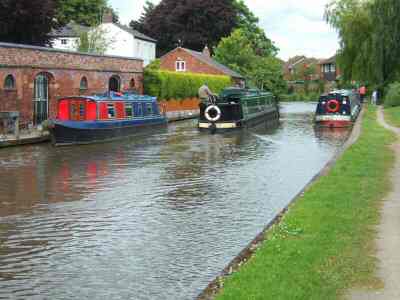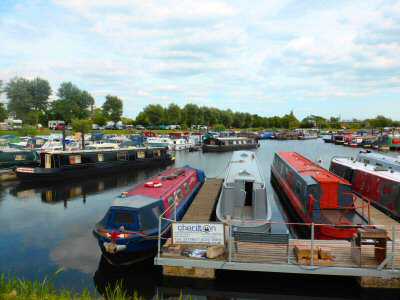SHARDLOW
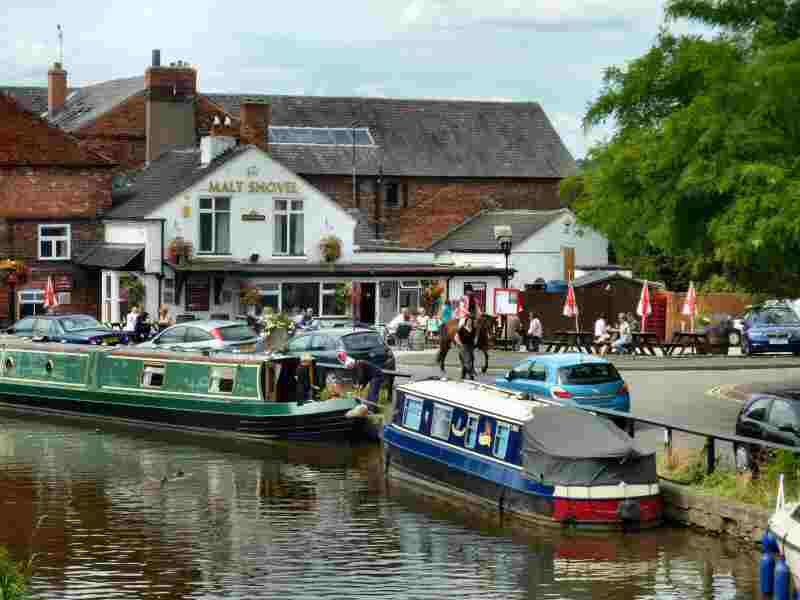
INFORMATION
Where is it? – On the old A6 (now B5010) Derby to Loughborough road (SK445303).
What to do? – Try to time your visit for when Shardlow Heritage Centre is open (check the website for opening times). It features displays of the canal and village life of this historic inland port; take a walk around the old village and stroll along the canal bank to Derwent Mouth Lock. Watch the boats negotiating the lock and a little further on see where the River Derwent joins the River Trent; visit Shardlow Marina with its vast array of colourful boats. Where you can also obtain refreshments and if you are very ambitious buy a boat!
Where to eat? – There are several pubs to choose from including the Malt Shovel (telephone 01332 792066), a cosy little pub with its open fire in winter and old-world atmosphere. Here you can also sit outside in good weather and enjoy watching the activity on the canal, the same applies to its next-door neighbour the New Inn. For more information visit: www.thenewinnshardlowpub.co.uk or telephone 01332 793330; Florentine Coffee and Patisserie is on the western side of Shardlow and faces the B5010. For more information telephone 01332 799673.
Other places to visit – Elvaston Castle Country Park was the first Country Park to be opened in Britain. Set on 200 acres of parkland with an ornamental lake, extensive gardens, stony grottoes, rock archways and many other interesting features. Open daily; visit the attractive village of Aston-on-Trent where on the southeast side the remains of an Iron Age settlement have been found. Early settlers were attracted by the fertile soil. This led to the 17th-century local historian Philip Kinder describing the area as ‘The granary of Derbyshire.’ Aston remained very much of an agricultural village until the 1960s. When modern developments began to take over and farmhouses became private dwellings; Donington Park is a motorsport circuit located near Castle Donington. It has a capacity of 120,000, and, is also the home of the Download Festival.
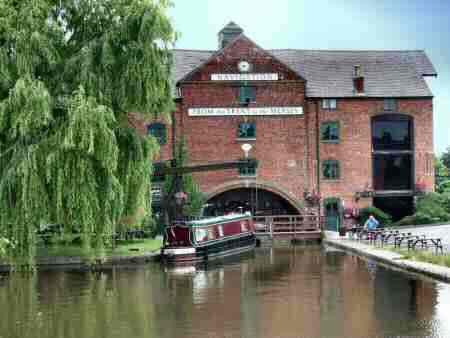
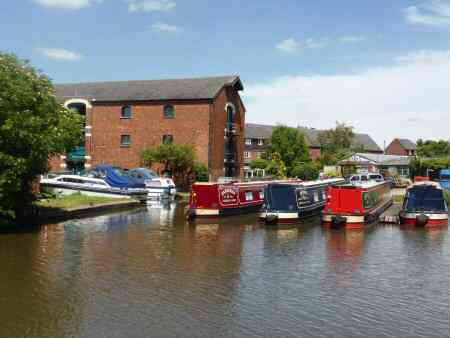
PROFILE
Shardlow is one of the best-preserved inland canal ports in the country. It is a fascinating place to explore, still busy with boats, now used for leisure and not for commerce. The boats range from traditional narrow boats with brightly painted liveries, in summer frequently be-decked with pretty boxes filled with flowers, to pleasure craft of all shapes and sizes. Boat people tend to be friendly and are usually more than happy to exchange a wave or a word or two which makes a walk along the towpath that much more enjoyable.
All this activity is good news for the canal-side pubs, which team with customers in the summer and at the weekend. The canal towpath brings you into contact with many of the old buildings of the Canal Age. Mostly now used for different purposes, but still largely intact. The massive warehouses that once stored ale, cheese, coal, cotton, iron, lead, malt, pottery and salt. Wharves where goods were loaded and unloaded. This is where the skilled craftsmen worked; the boat builders and repairers, the chandlers, rope-makers and blacksmiths. Idle Bridge was where men seeking employment used to wait to be engaged.

Waterways
Waterway traffic has always been important to the village. In the second half of the 17th century, Wilden Ferry, near Shardlow had become the head of the Trent navigation. This part of the Trent was leased from the Cokes of Melbourne Hall by the Forsbrooke family. They tried to monopolise river traffic between the ferry and Nottingham and were so successful that Shardlow Hall was built out of the profits. In 1760 the ferry was replaced by Cavendish Bridge. On the Derbyshire side is a toll board listing charges, ranging from two shillings and sixpence for coaches to a half penny for soldiers.
The use of river transport goes back much further than the days of the Wilden Ferry. In 1999, a twelve-foot-long oak boat was exposed by spring floods at Shardlow quarry, in the bed of a former side channel of the River Trent. The boat, probably dating from the middle Bronze Age, about 1300 BC, was still carrying some of its cargo of quarried stone. Archaeologists examining the find described its discovery as ‘spectacular’. A small remnant and other details of this discovery are available for inspection at the Heritage Centre.

Industry
Industry’s rapid growth in the second part of the 18th century required an improved and inexpensive transportation system if it was to be sustained. Much of the development was inland so the coastal route was usually out of the question. Rivers often obstructed by weirs and fish pools, rarely could be used for long-distance haulage. Roads had been improved by the growth of turnpikes but were not suitable for moving large volumes of goods. Packhorses were still relied on in Derbyshire to transport goods – slowly and laboriously. The time was ripe for a new form of effective transportation of heavy goods.
Canal Era
A solution to the transportation problem came from Derbyshire engineer James Brindley. He could not read or write properly but had a brilliant brain. Brindley astounded other engineers who laughed at his ultimately successful proposal. To find an economical way of transporting coal from the Duke of Bridgewater’s estate at Worsley to Manchester.
He did this by building an aqueduct over the River Irwell. It stood on three great stone arches, 17 feet up, with a towpath alongside the canal for the horses to pull the boats the 900 yards to the other side of the river. Brindley’s inventions continued and his most celebrated enterprise was the Trent and Mersey Canal, known as the Grand Trunk. It connected canal systems throughout the country. After it opened Shardlow became an important inland port.
End of era
The coming of the railways in the mid-1800s brought a decline in Shardlow’s prosperity. No longer was the canal busy with long-distance haulage. The warehouses were put to other uses and the area began to decay. A limited amount of canal trade continued until the 1950s when the last delivery of grain was made. The growth of the leisure boat industry in recent years has once again returned Shardlow to its former vibrancy. With the splendid new marina and boat builders’ yard completed in 1975 always busy with boats.
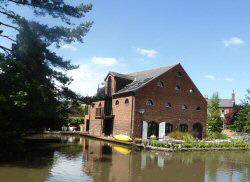
Industrial buildings are now recognised as a fundamental part of our heritage. Derbyshire is fortunate to have such an important survivor of the Canal Age within its boundaries. The Clock Warehouse, combining a pub and restaurant, is a spectacular restoration. Originally it was a place where goods were transferred from river barges to canal boats. The canal lock and boats make the area full of interest.
Shardlow Heritage Centre
For more information about Shardlow try the Heritage Centre. Run entirely by volunteers, it is only open on a limited basis details of which are available on the website. It is situated in what was a farrier’s shop. The centre is well laid out and packs an incredible amount of information into a small space.
The Old Canal Village
On the old A6 (now B5010), on the corner of Wilne Lane is The Navigation Inn, which once served river traffic, now a popular stopping point for visitors. Broughton House on the other side of Wilne Lane once belonged to one of the rich merchants, John Sutton, although he never lived there. It is said that he had it built to spoil the view of his business rivals, the Soresby family, who lived at The Lady in Grey. Formerly known as The Lodge located further down Wilne Lane.
The restored iron mileposts are an attractive feature along the canal bank. They mark every mile to Preston Brook near Runcorn, the northern end of the canal. The New Inn and The Malt Shovel, once the house of the manager of the attached malt warehouse, are popular canal-side pubs. By the village green are a row of attractive old canal workers’ cottages and the village community centre.
